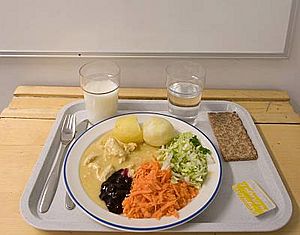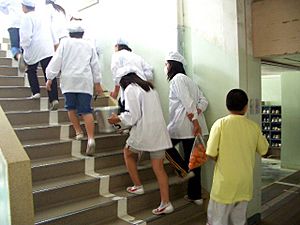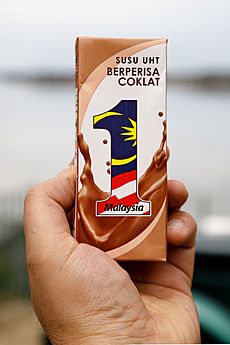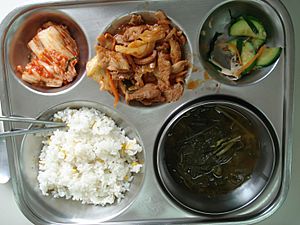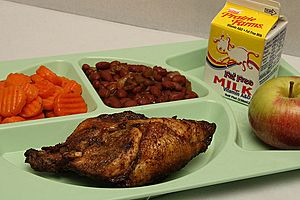School meal facts for kids
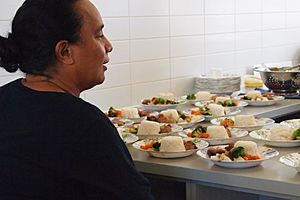
A school meal or school lunch is a meal given to students and sometimes teachers at school. It usually happens in the middle or at the start of the school day. Many countries around the world have different school meal programs. Every weekday, millions of children get meals at their schools. In many places, these meals provide healthy, high-energy food that is either free or very cheap.
School meals help kids in different ways. In richer countries, they make sure students get nutritious food. In developing countries, school meals can encourage children to come to school and stay in their classes. They also help families during tough times and help children grow into healthy adults. This can help break the cycle of poverty and hunger.
Contents
History of School Meals
The very first school lunches were served in 1790 in Munich, Germany. They were started by an American scientist named Benjamin Thompson. He created a place called the Poor People's Institute, where adults and children worked and were given food and clothes. The children also learned to read, write, and do math. Thompson was a pioneer in feeding large groups of people. He also helped introduce the potato to Europe and invented many kitchen tools we still use today.
In the United Kingdom, school meals have changed a lot since the 1800s. In 1941, the first national rules for school lunches were made. These rules said that school meals needed to be balanced and have enough protein, fat, and calories.
In the United States, during the time of the Industrial Revolution, many poor children were not getting enough to eat. Cities like Philadelphia and Boston started offering hot school meals that families could afford. Teachers soon noticed that students were doing better both mentally and physically. The government got involved during the Great Depression in the 1920s. School lunch programs helped farmers and workers, and also fed hungry children.
More recently, schools have been asked to change the foods they serve. For example, some schools now offer vegan lunches or have Meatless Mondays.
Types of School Meals
Free School Meals
Some countries, like Sweden, Finland, Estonia, and India, give free school meals to all students. This happens no matter how much money their families make. Many countries offer free meals to help more children attend school. In India, government schools provide free lunch as part of the Midday Meal Scheme.
In wealthier countries, free meals are usually only for children whose families meet certain income rules. A study in the United States found that giving free meals to elementary and middle school kids in areas where food was scarce helped students behave better at school.
Reduced Price Meals
Reduced price meals are also available in some countries. These are for families who need some help with the cost. Meals that cost less are offered to students in countries like France, Italy, Hong Kong, Japan, and the United States.
School Meals Around the World
Europe
Estonia
In Estonia, free school dinners are served in elementary and secondary schools. The rules for these meals are based on the Estonian food pyramid. This pyramid shows what foods should make up most of each meal, like starches, fruits, and vegetables. It also suggests eating smaller portions of dairy and meat, and only a little bit of high-sugar foods.
Finland
History of Finnish School Meals
Finland has provided free, hot school meals to all students since 1948. This is guaranteed by their Basic Education Act. Some Finnish cities had already offered free school dinners to poor students since the early 1900s.
Current Status in Finland
Today, the average school meal in Finland costs about 2.80 euros per student per day. This includes the food, staff, and kitchen equipment. Children who stay for before- and after-school activities also get a free healthy snack.
Lunches for university students in Finland are also cheaper thanks to government help. This program helps students eat healthy and promotes good eating habits. It also makes sure students with special diets (for religion, beliefs, or health) can get suitable meals without extra cost.
Learning Through School Meals
Free school meals in Finland are seen as an investment in children's future. They aim to keep kids healthy, happy, and learning well. The school meal is used as a way to teach good table manners, about different food cultures, and how to eat healthily. It also encourages eating more vegetables, fruits, wholemeal bread, and low-fat milk.
Students often help out in the school canteen as part of their work experience. Many schools have a school meal committee where students, teachers, and kitchen staff work together to improve school food. Adults are always present in the school restaurant. Students get at least 30 minutes to eat, followed by a short break outside.
What's on the Menu?
School meals in Finland usually include typical Finnish foods. A basic meal has a warm main dish, vegetables, bread, a spread, and a drink. The lunch is planned to provide about one-third of a child's daily nutrition needs. Schools often use a "model plate" to guide students on how to fill their plates:
- Half the plate with fresh and cooked vegetables.
- One-quarter with potatoes, rice, or pasta.
- The last quarter with fish (at least once a week), meat, or beans for vegetarians.
- Skimmed or semi-skimmed milk or fermented milk products.
- Water.
- Bread with margarine.
- Berries or fruit for dessert.
Children with special dietary needs get special meals without extra cost. For health-related diets, schools might ask for a note from a doctor or nurse.
The School Lunch Diploma
Finland has a "School Lunch Diploma" for schools that are committed to providing healthy, educational, and environmentally friendly school lunches. It also shows good teamwork within the school.
France
History of French School Meals
In the 1970s, the French government started working to make school lunches better. In 1971, they set rules for what should be in French school meals. These rules said that each meal should have raw vegetables (like salads and fruits), protein (like milk or dairy), cooked vegetables twice a week, and carbohydrates on other days.
Current Status in France
In France, lunch is a very important meal. Students can eat at school or go home for lunch. The lunch break is usually one to two hours long. French students are taught to take their time and enjoy their meals. Families pay for school lunches, but the school pays for the rest. For example, a meal might cost $6, but the family only pays $3.
What's on the Menu?
The rules from 2001 say that school lunches must be healthy and balanced. Menus change daily and are posted for parents to see. School meals should have very little fat, and lots of vitamins and minerals. The main dish must include meat, fish, or eggs.
French school cafeterias serve five-course meals, even for young children. Students eat the same kinds of foods as adults. A school lunch in France includes an appetizer, salad, main course, cheese plate, and dessert. Bread is often served with each meal. An example meal might be potato leek soup, carrot and bean salad, lamb with saffron, different cheeses, and grapefruit. Water is always served. French schools do not have vending machines.
Italy
School meals in Italy usually offer regular Italian cuisine, but the dishes can change depending on the region or town. The Italian government is studying food habits and choices to involve students more. However, many parents find school food expensive and want the right to pack meals for their children.
Norway
During World War II, Norway received school lunches from Sweden. Later, public school lunches stopped, so most Norwegian students now bring a packed lunch from home. Since 2007, schools have given one free piece of fruit each day to students in grades 8–10. Norwegian schools also sell milk at a lower price.
Sweden
School lunches have been free in Swedish elementary schools since 1973. The government pays for all costs. School lunches are usually served buffet-style. This means students can choose from potatoes, pasta or rice; meat or fish; and vegetables. Milk and water are usually offered as drinks. There are also vegetarian options and foods that meet religious needs, all free of charge.
Many schools have teachers or the principal eat with the students. This helps create a stronger connection between students and school staff. Swedish schools also have international food weeks or vegetarian weeks. A study from 2021 found that free, healthy school lunches in Sweden led to better health and education for students, and even higher incomes when they became adults.
United Kingdom
History of UK School Meals
School meal programs in the United Kingdom started way back in 1906. In 1944, the UK government made it a rule for local areas to provide school dinners that met certain nutrition standards. The government paid the full cost of school meals in 1947. Free school meals were given to children from very low-income families.
In the 1980s, the government changed the rules, which meant fewer children got free meals. Schools also started using outside companies to provide meals, which often led to lower quality food. A survey in 1999 found that children in the 1950s had healthier diets than those in the 1990s.
This became a big topic in 2004 when famous chef Jamie Oliver started a campaign to make school meals better. At that time, school dinners often included a lot of deep-fried fast food. After his TV show "Jamie's School Dinners," many people supported more funding for school meals. This led the government to create the School Food Trust.
A young girl named Martha Payne also made headlines with her blog called NeverSeconds. She wrote about the quality of school meals at her primary school, and Jamie Oliver supported her.
Current Status in the UK
Since September 2014, all young children (ages four to seven) in English schools have been able to get a free hot meal at lunchtime every day. This idea came from Deputy Prime Minister Nick Clegg. The Scottish government has also provided free school meals for all children in Primary One to Three since January 2015. Similar programs are in place in Wales and Northern Ireland.
The British government uses free school meal eligibility to measure how many families are struggling financially. Schools get extra money for each child who qualifies for free meals.
School Meal Standards 2014
The school meal standards for England, updated in 2014, include:
- High-quality meat, poultry, or oily fish.
- Bread, cereals, or potatoes.
- At least one serving of vegetables or salad every day.
- At least three different fruits and three different vegetables each week.
- A focus on whole grain foods instead of refined carbohydrates.
- Making water the main drink.
- Limiting fruit juice to small portions.
- Restricting added sugars in other drinks.
- No more than two servings a week of deep-fried, battered, or breadcrumb-coated food.
- No more than two servings of food with pastry each week.
- A ban on drinks with added sugars, crisps, chocolates, or sweets in school meals or vending machines.
Who Can Get Free School Meals?
As of November 2020, parents can apply for free school meals for children at school if they receive certain benefits, such as:
- Income Support
- Income-based Jobseeker’s Allowance
- Income-related Employment and Support Allowance
- Support under the Immigration and Asylum Act 1999
- The guaranteed part of Pension Credit
- Child Tax Credit (if not getting Working Tax Credit and with a low income)
- Working Tax Credit run-on
- Universal Credit (with a household income under £7,400 a year)
Also, all children in their first three years of primary school (Reception, Year 1, and Year 2) get free meals.
Helping Disadvantaged Children
When a child receives Free School Meals, their school also gets extra money called a Pupil Premium. This money helps the school support these students. Schools are judged on how well they help these students catch up with others.
Advocacy for School Meals
The National Union of Teachers supports free school meals for all children. Many people believe that free school meals for all students can help them do much better in school.
During the Covid-19 pandemic lockdown, many children who usually got free school meals were at home and not getting enough food. A famous footballer named Marcus Rashford led a successful campaign to convince the government to continue providing meals or food vouchers. His petition for Free School Meals gained over a million signatures.
Asia
China
A typical school lunch in the People's Republic of China includes a main food like rice, a meat dish, and a vegetable dish. Students can usually choose two or three dishes. In poorer rural areas, the government has started "nutritious lunch" programs to help fight malnutrition.
India
Midday Meal Scheme School meals are provided for free at public schools in India.
History of Indian School Meals
India's school meal program started way back in 1925 in Madras. In 1975, the Indian government created the Integrated Child Development Services (ICDS) program. Under the Midday Meal Scheme, government high schools and some aided schools provide midday meals to students. As of 2019, the total cost of providing free meals to students in India was about $2.45 billion.
By 1998, India had a program called the National Programme of Nutritional Support to Primary Education. In the 2013-2014 school year, this program helped over 104 million children in more than a million schools.
What's on the Menu?
A single afternoon lunch usually has a cereal that is common in the local area, prepared in a traditional way. Each child also gets milk, and either soup or vegetables cooked as curry. For primary students, the meal must include 100 grams of food grains, 20 grams of protein, 50 grams of leafy vegetables, and 5 grams of oil and fat. Older students get slightly more. These meals are planned to provide a certain amount of calories and protein each day. Students can also get vitamin, iron, and folic acid tablets from the National Health Mission.
Children in private schools usually bring their own lunch boxes. Many schools also have canteens, and street food vendors are often found near school campuses.
Iran
In the 1960s, Shah Mohammad Reza Pahlavi started reforms called the White Revolution. One of these reforms, in 1975, was a program for 'Free and Compulsory Education and a daily free meal' for all children from kindergarten to 14 years old. This program gave free milk, pistachios, fresh fruit, and biscuits to all children in Iran.
Japan
History of Japanese School Meals
In Japan, school lunches began in the early 1900s. After World War II, when food was very scarce, the Japanese government brought back school lunches in cities. By 1952, all elementary schools in Japan had school lunch. In 1954, a law made school meals available in junior high schools too.
These early lunches included things like bread and skimmed milk powder. Later, they added flour given by an American charity, a dessert, and a daily changing dish. Inexpensive proteins like stewed beans and fried white fish were common. Whale meat was even served until the 1970s. Rice was added in 1976. Foods like Hamburg steak, stew, and Japanese curry became common too.
Current Status in Japan
As of 2004, almost all elementary school students (99%) and most junior high school students (82%) in Japan ate kyūshoku (school lunch). The food is grown locally, is almost never frozen, and is the same for every student (unless they have special dietary needs). Children in most areas cannot bring their own meals to school until high school, and schools don't have vending machines. Instead, children are taught to eat what they are served.
In both elementary and middle school, students put on white coats and caps to serve their classmates. Everyone then eats together in their classrooms, not in a cafeteria. To make lunches affordable, local governments pay for the staff, while parents pay for the ingredients. This usually costs about 250 to 300 yen (about USD $3) per meal. There are cheaper or free options for poorer families.
What's on the Menu?
Daily lunches are planned by nutritionists to be balanced and tasty. They try to appeal to picky eaters. Japan's central government sets basic nutrition rules, but schools have a lot of freedom. The meals are often very high quality, almost like restaurant food. You usually won't see dessert, other than fruit and yogurt. Fried food is sometimes served, but not often.
Malaysia
In most Malaysian schools, students eat in a canteen where they buy food and drinks from different stalls. School canteens usually offer Malay, Chinese, and Indian foods, with different types of rice, noodles, and breads. Common dishes include Nasi Lemak, Nasi Goreng, Chicken Rice, Popiah, and Laksa.
School canteens sell food and drinks at lower prices. Students from less fortunate families can apply for a free-food program. This program is often supported by the school's parent-teacher group or the Ministry of Education. Low-income students might also get free milk through the School Milk Program.
Philippines
School meals in the Philippines are usually simple, mainly consisting of rice, meat, and gravy.
Singapore
School meals in most Singaporean primary and secondary schools, as well as junior colleges, are provided in the school's canteen (or tuckshop). The canteens have stalls that sell a variety of foods and drinks. To serve different races, religions, and cultures in Singapore, canteens often offer many types of food, like Chinese, Indian, Malay, and Western dishes.
To encourage healthier eating, the Health Promotion Board of Singapore started the Healthy Eating in Schools Programme. Schools that serve healthy meals can win an award. To get the award, schools must use less sugar in drinks and desserts, serve fewer deep-fried and fatty foods, and include two servings of greens in their meals.
South Korea
South Korea has provided free school lunches to low-income students since the 1980s, for both primary and secondary school levels.
North America
Canada
Canada does not have a national school meal program. Elementary schools usually don't have kitchens. Parents are generally expected to pack a lunch for their children, or children go home to eat during the lunch break. However, some groups do exist to help with student nutrition programs. Most Canadian middle schools (grades 6-8) and high schools (grades 9-12) have cafeterias that serve hot meals.
United States
History of US School Meals
School lunches at the national level started as a temporary project in 1933. It was a way to give jobs to unemployed people, feed hungry children, and use up extra farm products. The permanent National School Lunch Program was created in 1946 with the National School Lunch Act. This law helped farmers by buying their extra food and also aimed to keep children healthy.
Current Status in the US
Today, the National School Lunch Program is a federal program that helps over 101,000 public schools, private schools, and care institutions. It is managed by the Food and Nutrition Service of the United States Department of Agriculture (USDA). The program provides "nutritionally balanced meals" at a low cost or no cost to more than 31 million children every school day.
The program has grown a lot. It now includes the School Breakfast Program, the Snack Program, and the Summer Food Service Program. School meal programs in the United States give free or cheaper meals to children from low-income families. Those who don't qualify pay a small fee.
What's on the Menu?
School lunches must follow the Dietary Guidelines for Americans. These rules say that no more than 30 percent of a person's calories should come from fat, and less than 10 percent from saturated fat. School lunches must also provide one-third of the daily recommended amounts of protein, Vitamin A, Vitamin C, iron, calcium, and calories. Schools can decide what specific foods to serve and how to prepare them.

Former First Lady Michelle Obama was a big supporter of healthy school lunches. Since the Healthy, Hunger-Free Act of 2010, she worked hard to promote healthy school meals. Schools have sometimes found it hard to follow all the nutrition rules because children were not eating their lunches. To find a balance, they agreed to serve more fruits and vegetables and more whole grains, and to reduce salt levels.
Vending machines in schools are also a source of food for students. Because of concerns about childhood obesity, many school districts have banned sodas, junk foods, and candy from vending machines and cafeterias. Healthier vending machine options are becoming more popular in schools.
Africa
Nigeria
In April 2012, the State of Osun in Nigeria started a statewide school meals program for all public elementary school students. It's called the O'Meals program. By July 2014, it was providing lunch to over 252,000 children. The program serves Nigerian staple foods like rice, beans, and yams with stews, soups, and vegetables, plus daily fruits. It costs about N50 (USD $0.31) per child per day.
The O'Meals program has had many benefits:
- School enrollment increased by about 25% within four weeks of starting.
- It has helped over 3,000 previously unemployed women by hiring them as food vendors.
- All food items are bought locally from farmers, which helps the economy in the state.
- Addressing child malnutrition has improved students' academic performance.
In 2015, the All Progressives Congress (APC) party suggested a nationwide free meal plan. Since becoming President, Muhammadu Buhari has made this a top goal. The government of Kaduna State has also started a school feeding program.
Oceania
Australia
The Healthy Kids Association is a group in Sydney, Australia that promotes health. It works with school canteens in New South Wales and the Australian Capital Territory. In Australia, many school canteens had started offering junk food, or students were buying fast food outside school. The association has created rules to change this.
In 2002, the Premier of New South Wales, Bob Carr, launched the "Fresh Tastes NSW Healthy School Canteen Strategy." This plan aims to help schoolchildren develop a taste for healthier foods by promoting healthy menu options and limiting less nutritious foods.
New Zealand
Until 2020, New Zealand did not have a national school meal program, except for some school breakfasts run by local boards. After taking office, the Labour-led government announced that 20,000 children would get school lunches by 2021. Prime Minister Jacinda Ardern said this program would expand to 200,000 students by the end of 2021 if her party stayed in power.




